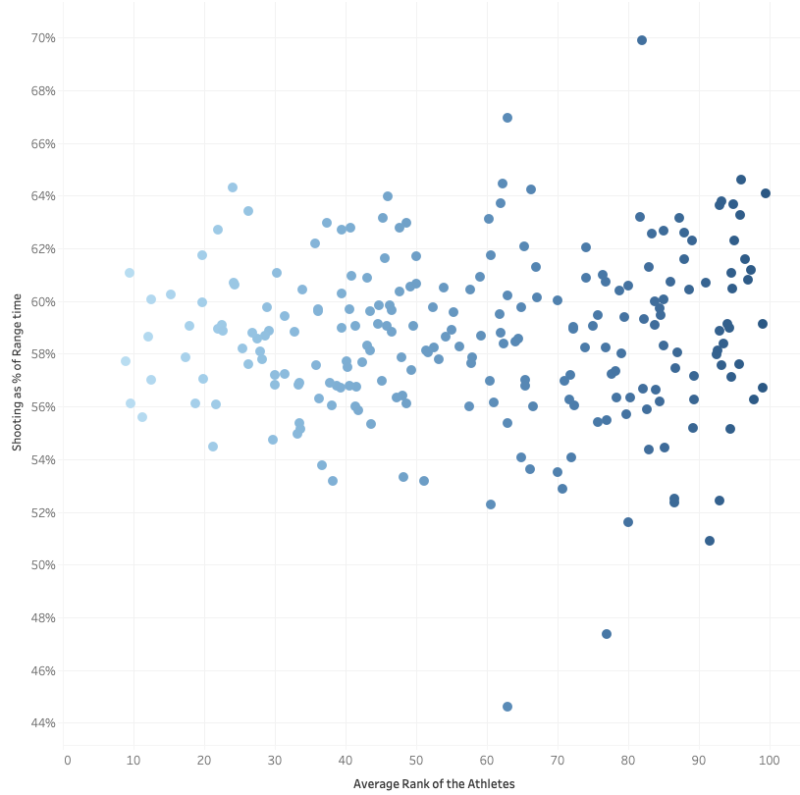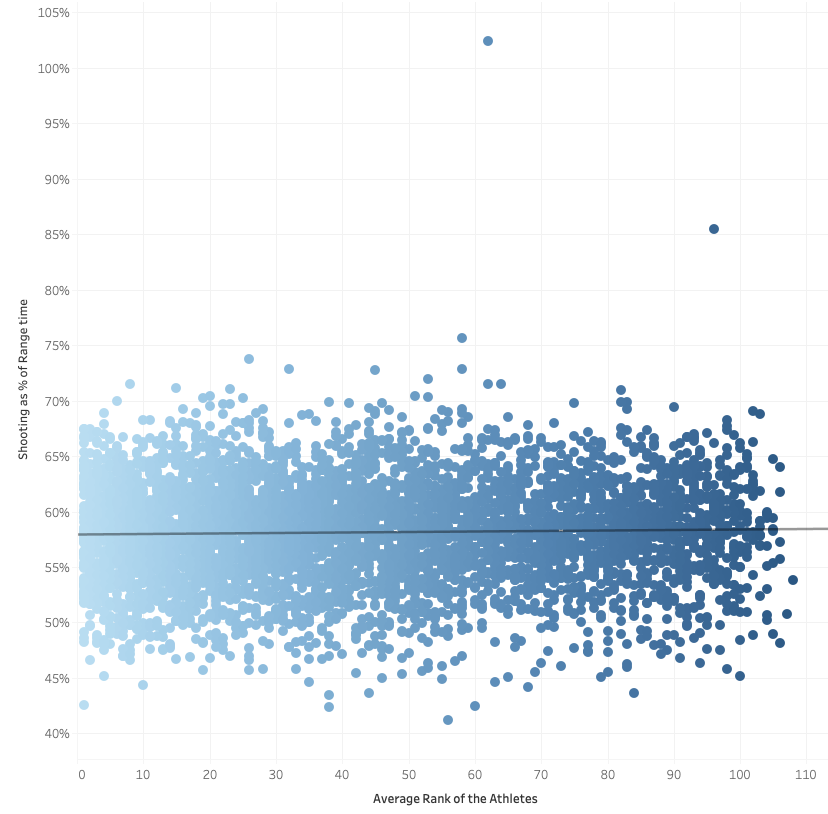After watching the final season races in Oestersund, and one moment in one race specifically, I wanted to do further analysis into the time that athletes prepare themselves for shooting and for skiing after the shooting. And see if this would be even possible. But first, let me show you the moment that triggered this:
Stina Nilsson takes FOREVER to put her poles back on and get back to fully functioning skiing after her prone shoot in the Women’s Sprint race in Oestersund. It made me wonder if there is a way to analyze how fast or slow athletes are outside of the shooting while not skiing on the course. Taking poles and rifle off, getting in position, getting the rifle and poles back on and getting skiing again.
Data
The data I hope we can use for this is the Range time and the Shooting Time. As I’m interested in the time on the Range but while not shooting, it’s a simple subtraction: Range time – Shooting time = Prep time. So Prep time is the time spent in the Range while not shooting. That would be the time described above, getting off the poles and rifle, getting ready, and then getting moving again.
The only problem is that there are athletes like Stina Nilsson that take so long to get the poles back on that they already have left the range. Now I’m sure this happens more often (especially for those athletes shooting in the lane closest to the penalty zone at end of the range) but I don’t recall ever seeing an athlete going past the time recording and still having to start putting on the second pole!
Can we use this data then?
Ironically when I look at Stina’s race data, her Range time rank is 57th (103.1 sec.) and her Shooting time rank is 70th (62.3 sec.). But she does have the fastest Prep time of the whole race. We know that a) her prep goes well beyond the range, and b) there is logic in that the more time you spend shooting while in the range, the less time you have for Prep while in the Range. Considering this, the Range and Shooting time are not able to answer who is faster and slower at “prepping”, and I don’t think there is data available that can actually answer this question.
Alternative insights perhaps?
What is still interesting though is to look at how much of the Range time is used for shooting. At least that will tell something about the time spent not shooting while in the Range. In this specific race, it varied from 33% to 53% of Range time, which tells you there is still a lot of time to be gained by either skiing / gliding a bit faster in the range before the shooting, getting in position faster, and getting up and going after the shooting.
Phases
Another fact we cannot get from the data is that the phases before and after the shooting are very different. The phase before shooting is focused on slowing down, reducing the heart rate and focussing on the shooting. In other words, this tends to be slow. The phase after the shooting is fast and all focussed on getting ready and on to the course to ski.
Depending on what lane the athlete shoots in, the distance spent in these two phases while inside the Range area differs significantly. This also means we cannot look at these data for one race and draw any conclusions. For all races in three seasons, however, this should even out to some degree, although I would expect that the top athletes who shoot in the last lanes most of the time spend more time in the slow phase while in the Range area.
Alternative insights perhaps? – Part II
Sticking with the women’s field but including all races since the 2018-2019 season, we now see the average percentage of Range time spent shooting varies from 45% to 70%. Or 30% to 55% spent not shooting. Let’s check that assumption that higher-ranked athletes would be slower because they relatively spend more time in the slow phase due to their shooting lane. first I look at the average rank and average time spent shooting per athlete:

This only shows us that as the Ranks get higher there is more variability between the athletes. How about the same but per athlete and race:
 The trend line is barely statistically significant (p ~ 0.05%) but the R-square value tells me not much variation is explained by the model.
The trend line is barely statistically significant (p ~ 0.05%) but the R-square value tells me not much variation is explained by the model.
What ever it does and does not tell me, my question if higher ranked athletes are spending more time in the slow phase and thus slower in the time spent not shooting is not answered. On top of that, higher ranked athletes are generally speaking better shooters, both accuracy and speed, so that is another variable in the mix.
Conclusion
My sad conclusion is that based on the available data we cannot make any conclusions about how fast or slow athletes are prepping for shooting and then for skiing. If we would have data that starts from the moment the athletes prepares for shooting and continues until an athlete is in full skiing position, I don’t see how I can come to any conclusion on this topic. Perhaps I should rename this piece “Ramblings about Preparation time.” Nah. Hopefully, these ramblings will trigger something with readers and who knows where that may lead?